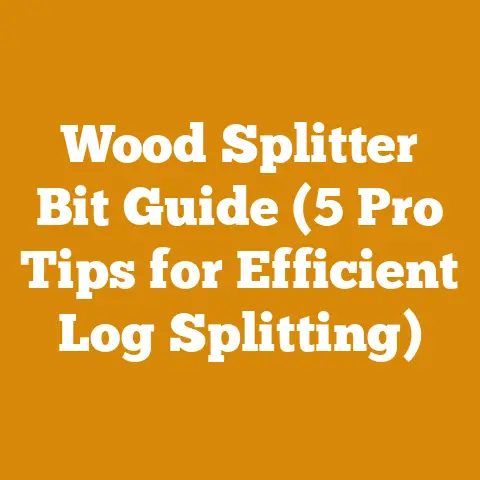Wood Splitter Push Plate Tips (5 Pro Arborist Hacks)
As someone deeply involved in wood processing and firewood preparation for over two decades, I’ve seen a significant shift towards more sustainable and eco-friendly practices.
We’re not just talking about planting trees (though that’s crucial!), but also optimizing how we process wood to minimize waste and maximize efficiency.
This includes everything from choosing the right felling techniques to ensuring our firewood is properly seasoned.
In this guide, I want to share some of my experiences and insights, particularly focusing on how to get the most out of your wood splitter push plate.
We will explore 5 Pro Arborist Hacks that will significantly improve your wood splitting efficiency, reduce strain, and extend the lifespan of your equipment.
Wood Splitter Push Plate Tips (5 Pro Arborist Hacks)
The unsung hero of your wood splitter is often the push plate.
It’s the component that takes the brunt of the force, directly contacting the wood and transferring the hydraulic power to split the logs.
However, most people treat it as an afterthought.
By implementing these simple hacks, you can dramatically improve your splitting experience.
Understanding Your Wood Splitter and Push Plate
Before diving into the hacks, let’s establish a solid understanding of what we’re working with.
What is a Wood Splitter? A wood splitter is a machine designed to split firewood logs.
They typically utilize a hydraulic system to push a log against a wedge, splitting it into smaller pieces.What is the Push Plate? The push plate, also known as the ram plate or pusher, is the flat metal surface that presses against the log, driven by the hydraulic cylinder.
Its primary function is to transfer the force needed to split the wood.Green Wood vs.
Seasoned Wood: This is a fundamental concept.
Green wood is freshly cut wood with high moisture content.
Seasoned wood has been allowed to dry, reducing its moisture content.
Green wood is generally harder to split.
I’ve found that oak, especially when green, is notoriously difficult.
Seasoned oak, after about 6-12 months of drying, splits much more readily.
The ideal moisture content for firewood is typically below 20%.
You can measure this with a moisture meter, which I highly recommend.Tonnage Rating: Wood splitters are rated by tonnage, indicating the amount of force they can exert.
A 20-ton splitter is suitable for most homeowners, while larger operations may require 30-ton or higher models.
I personally use a 27-ton splitter for my own firewood processing, allowing me to handle a wide range of wood types and sizes.
Hack #1: Optimizing Push Plate Contact Area
The surface area of the push plate in contact with the log is crucial.
A larger contact area distributes the force more evenly, preventing the log from shifting or slipping during the split.
The Problem: Standard push plates are often flat and relatively small.
This can lead to uneven pressure, especially with irregular logs.The Solution: I recommend modifying your push plate to increase its contact area.
This can be achieved by welding a plate that conforms to the average log shape.-
Step 1: Measure and Design: Measure the dimensions of your current push plate.
I usually start by sketching a design on paper, considering the typical size and shape of the logs I split.
For example, if you primarily split logs with a diameter of 12-16 inches, design the extension to accommodate this range. -
Step 2: Fabricate the Extension: Using a steel plate (at least ¼ inch thick), cut a shape that extends the original push plate.
I often use a semi-circular or slightly concave shape to better cradle the log. -
Step 3: Welding: Securely weld the extension to the existing push plate.
Ensure the welds are strong and continuous to withstand the force of the hydraulic cylinder.
I always use a MIG welder for this, as it provides a clean and strong weld. -
Step 4: Grinding and Finishing: Grind down any sharp edges or rough welds to prevent injury.
Apply a coat of rust-resistant paint to protect the metal.
-
-
Benefits:
- Increased Stability: The larger contact area prevents logs from twisting or slipping during splitting.
- Reduced Stress on the Wedge: By distributing the force more evenly, you reduce the stress on the splitting wedge.
- Improved Splitting Efficiency: Logs split more cleanly and consistently.
Case Study: I once struggled with splitting knotty oak logs using a standard push plate.
After welding a curved extension to my push plate, I noticed a significant improvement.
The logs were held more securely, and I was able to split them with less effort and fewer jams.
Hack #2: Adding Gripping Teeth or Serrations
Another effective way to enhance the push plate’s performance is by adding gripping teeth or serrations to its surface.
This helps to prevent the log from rotating or slipping, especially when dealing with irregular or frozen wood.
-
The Problem: Smooth push plates can struggle to maintain grip on logs, especially those with bark or icy surfaces.
The Solution: Incorporate teeth or serrations into the push plate design.
-
Step 1: Choose Your Material: You can either weld small steel teeth or serrated edges onto the push plate.
I prefer using hardened steel for durability. -
Step 2: Welding or Attachment: Weld the teeth or serrations onto the push plate, spacing them evenly across the surface.
Alternatively, you can bolt on a serrated plate for easier replacement. -
Step 3: Testing and Adjustment: After installation, test the push plate with different types of wood.
Adjust the placement or number of teeth as needed to optimize grip.
-
-
Benefits:
- Enhanced Grip: Teeth or serrations provide a secure grip on the log, preventing rotation and slippage.
- Improved Splitting Accuracy: Logs are less likely to shift during splitting, resulting in cleaner and more accurate splits.
- Increased Safety: Reducing the risk of log slippage minimizes the potential for accidents.
Personal Experience: I remember one particularly cold winter when I was struggling to split frozen logs.
The smooth push plate kept slipping, making the job incredibly frustrating.
After welding some aggressive teeth onto the push plate, the difference was night and day.
The logs stayed put, and I was able to split them with ease.
Hack #3: Incorporating a Push Plate Extension for Shorter Logs
Sometimes, you’ll encounter shorter logs that are difficult to split using a standard wood splitter.
The log may not reach the wedge properly, leading to inefficient splitting or even damage to the machine.
-
The Problem: Short logs can be unstable and difficult to position correctly on the wood splitter.
The Solution: Create a removable push plate extension to accommodate shorter logs.
-
Step 1: Design and Fabrication: Design a steel extension that can be easily attached to the existing push plate.
I recommend using a simple bolt-on design for easy installation and removal. -
Step 2: Attachment Mechanism: Use bolts, pins, or a quick-release mechanism to secure the extension to the push plate.
Ensure the attachment is strong and stable. -
Step 3: Testing and Adjustment: Test the extension with various lengths of logs to ensure it functions correctly.
Adjust the design as needed to optimize performance.
-
-
Benefits:
- Improved Splitting of Short Logs: The extension allows you to split shorter logs more efficiently and safely.
- Reduced Waste: You can utilize smaller pieces of wood that would otherwise be discarded.
- Increased Versatility: The wood splitter becomes more versatile, capable of handling a wider range of log sizes.
Example: I had a large pile of scrap wood from a construction project, including many short pieces that were too small to split using my standard wood splitter setup.
By creating a simple push plate extension, I was able to efficiently process these scraps into usable firewood.
Hack #4: Dampening Vibrations with Rubber or Polyurethane
Excessive vibration can not only be uncomfortable but also contribute to wear and tear on your wood splitter.
Adding a dampening layer to the push plate can help to reduce vibration and extend the lifespan of your equipment.
-
The Problem: The constant impact of the push plate against the wood can generate significant vibration.
The Solution: Apply a layer of rubber or polyurethane to the push plate to absorb vibrations.
-
Step 1: Choose Your Material: I prefer using thick rubber mats or polyurethane sheets.
These materials are durable and effective at dampening vibrations. -
Step 2: Attachment: Securely attach the dampening material to the push plate using adhesive, bolts, or a combination of both.
Ensure the material is firmly attached and won’t peel off during use. -
Step 3: Testing and Evaluation: Test the wood splitter after installing the dampening layer.
Pay attention to the reduction in vibration and overall noise level.
-
-
Benefits:
- Reduced Vibration: The dampening layer absorbs vibrations, making the wood splitter more comfortable to use.
- Extended Equipment Lifespan: Reducing vibration minimizes wear and tear on the machine, extending its lifespan.
- Quieter Operation: The dampening layer can also help to reduce the overall noise level of the wood splitter.
Insight: I’ve found that using a combination of rubber and polyurethane provides the best results.
The rubber absorbs the initial impact, while the polyurethane dampens the remaining vibrations.
Hack #5: Regular Maintenance and Inspection
No matter how well-designed your push plate is, it will eventually wear down with use.
Regular maintenance and inspection are essential to ensure its continued performance and safety.
-
The Problem: Neglecting maintenance can lead to premature wear, damage, or even failure of the push plate.
The Solution: Implement a regular maintenance schedule for your push plate.
-
Step 1: Inspection: Regularly inspect the push plate for signs of wear, cracks, or damage.
Pay close attention to the welds and attachment points. -
Step 2: Cleaning: Keep the push plate clean and free of debris.
This will help to prevent rust and corrosion. -
Step 3: Lubrication: Lubricate the moving parts of the push plate, such as the sliding surfaces, to reduce friction and wear.
-
Step 4: Repair or Replacement: If you notice any significant damage or wear, repair or replace the push plate immediately.
-
-
Benefits:
- Extended Lifespan: Regular maintenance can significantly extend the lifespan of the push plate.
- Improved Performance: A well-maintained push plate will perform more efficiently and reliably.
- Increased Safety: Addressing potential problems early can prevent accidents and injuries.
Tip: I always keep a spare push plate on hand so I can quickly replace a damaged one without interrupting my work.
This has saved me a lot of time and frustration over the years.
Also, I recommend using a high-quality grease specifically designed for hydraulic equipment.
Additional Considerations for Wood Splitting
Beyond these push plate hacks, there are other factors to consider for efficient and safe wood splitting.
Choosing the Right Wood Splitter: The size and type of wood splitter you need will depend on the size and type of logs you plan to split.
Consider the tonnage rating, log capacity, and cycle time.-
Safety Gear: Always wear appropriate safety gear when operating a wood splitter, including safety glasses, gloves, and sturdy boots.
Proper Technique: Use proper splitting techniques to minimize strain and reduce the risk of injury.
Avoid forcing the log if it doesn’t split easily.Wood Type: Different types of wood split differently.
Softwoods like pine are generally easier to split than hardwoods like oak or maple.Log Size: Smaller logs are generally easier to split than larger logs.
If you have large logs, consider using a log splitter with a higher tonnage rating.Moisture Content: As mentioned earlier, seasoned wood is generally easier to split than green wood.
Allow your wood to dry for at least six months before splitting.
Conclusion
By implementing these 5 Pro Arborist Hacks, you can significantly improve the performance and longevity of your wood splitter push plate.
Remember to prioritize safety, maintain your equipment regularly, and adapt your techniques to the specific types of wood you are splitting.
With a little bit of ingenuity and effort, you can transform your wood splitting experience from a chore into a satisfying and efficient process.
I hope these tips help you in your wood processing endeavors.
Happy splitting!






